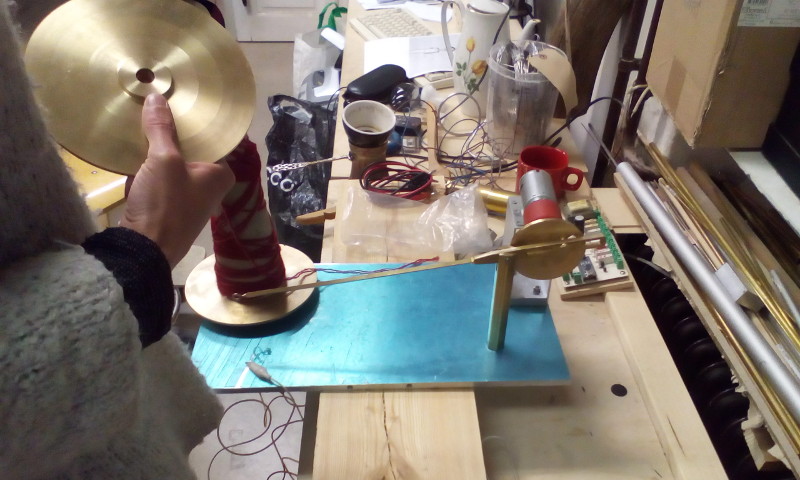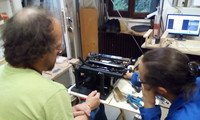V zavetrju časa
Category: Expositions
Collaborators: Meta Grgurevič, Urša Vidic, Zoran Srdić Janežič

V zavetrju časa was a multi-media spatial installation by Meta Grgurevič and Urša Vidic, loosely based on the novel To the lighthouse by Virginia Woolf. It was on display on June 2016 in Ljubljana Puppet Theatre and included lights, sound, music, video, performance and kinetic objects. If you have already read other articles about my projects with Meta and Urša, you probably guessed that my role in this project was the automatisation of the kinetic objects.
Considering my limited role in this production, I will not write much about the installation in general. It suffices to say that I went to see it as a member of audience and I was very impressed with it. Here I concentrate on the objects I was working with.
The design for the kinetic objects was done primarily by Meta. In addition to the ones that did not need any attention from me, there was a machine slowly pulling on a huge sheet of knitwork and wrapping the unraveling yarn back on a cone. Then there was a set of six long rods, holding and moving light bulbs on the surface of a puddle of water. Still further, a device for making a dress to dance by itself in the air. And there was a self typing typewriter. Finally, Urša brought in Glassworks #1 which had also been separately exhibited earlier.
Meta did the metalworks together with France Petač in his workshop. Further construction was done in the puppet theatre’s workshop with Žiga Lebar and Zoran Srdić Janežič. Meanwhile I worked on electronics. As most of the devices had very similar requirements, I decided to design a single controller board. The design was then realized as printed circuit board.
The controller was to drive up to three geared dc motors, with possibility of speed control and changing the direction of rotation. Thus it was practical to use a h-bridge controller. Some devices additionally needed to limit their movement, so I added option for two limit switches for each motor. This design turned out to be relatively simple, yet versitale.
For h-bridge I chose BA6956AN, even though due to long delivery time I did not have any samples to try. This meant ordering printed circuit boards without building any kind of prototype first. Perhaps unexpectedly, this led to some mistakes sneaking in to the printed circuits. Apart from not working as expected, the circuit actually blew up the h-bridge chip when powered. This led to some quite unpleasant moments when the schedule was already very tight. Luckily it turned out that the problems were correctable with a knife, some solder and modest amount of careful work.
The hardware design and firmware is available in my GitHub repository dc-motor-controller.
The self typing typewriter was an exception to the rest of the devices. Pulling the keys was achieved by electromagnet coils hidden inside the table on which the typewriter sat. Due to this I had to design and build a separate controller and driver unit for the typewriter.
The coils were constructed by Meta, being some kind of continuation of our work with first levitation machine, Crystal C levitation machine and Invocation of Asta. Five keys were selected and hooked to coils with steel wire. The coils were driven by the controller which was programmed to use randomized sequence and timings. The end result was eerie looking balderdash appearing on paper accompanied by striking visual and audible effect.
Perhaps the most intriguing part of the typewriter was the return mechanism. Žiga added a system of levers to automatically feed a new line on the paper when the end of line was reached, so that the typing would continue on a new line. Naturally this also required that the carriage was returned simultaneously. For this one more dc motor was added. The motor was fitted to a specially constructed gear which had teeth only on part of its circumference. The gear paired with a linear strip of teeth fixed to the typewriter carriage. When the motor was arranged to run in a specific manner, the gear and strip construction allowed the motor to return the carriage, yet stay out of the advancing carriage’s way when the typewriter was typing.
The return mechanism actually worked quite well. Getting the motor to stop in the right position was quite hard, as there was no closed loop control for the dc motor. However with careful selection of motor speed it was possible to get the motor to reliably stop in the desired position.
Hardware design and firmware for the typewriter controller is available on my GitHub repository auto-typer.



